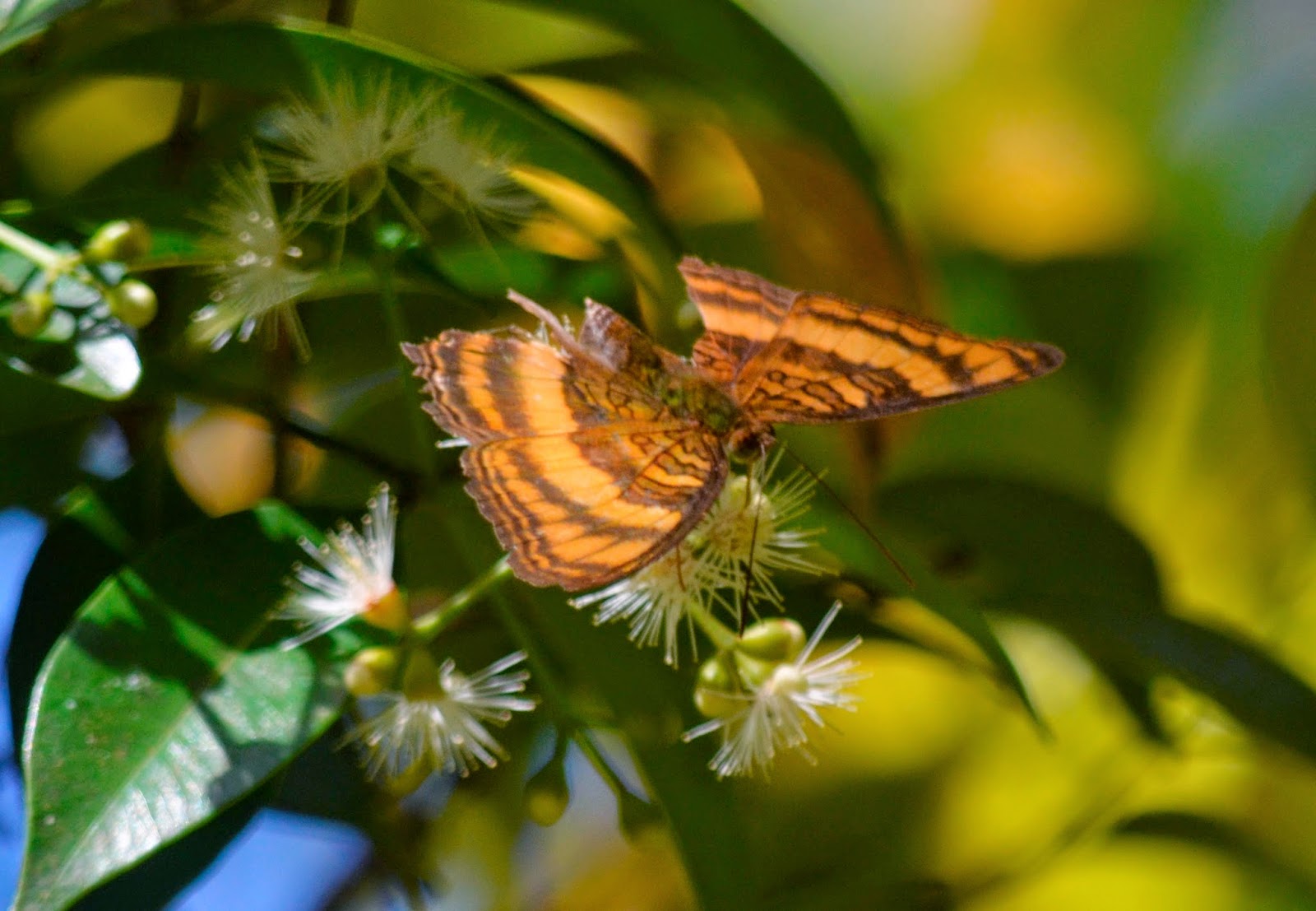Saturday, January 31, 2015
Friday, January 30, 2015
By the flowers of oleina #1 - Malay Lacewing
 |
| Malay Lacewing - Cethosia hypsea hypsina |
Just yesterday I noticed only a handful of the Eugenia oleina trees at the park bursting with fresh flower buds and flowers. Today at least a dozen of the trees simultaneously flower profusely. The trees are everywhere in the park - on slopes and hills, along roads and streams and open garden areas. Thus the butterflies too are seen everywhere. I intend to capture as many species of butterflies that are attracted to the oleina flowers this season. To start with the series is this beautiful lacewing butterfly. The most intricate patterns are on the underside wings which display a lacy design enriched in colours of black, red, cream, bright orange and white. The upperside wings have very attractive bright orange, white and black design.
 |
| Underside of the Malay Lacewing |
 |
| Attractive orange, black and white colours on the upperside |
 |
| Eugenia oleina trees are seen flowering at the park since about two days ago. The season of flowering has come and so are the many species of butterflies that are attracted to the white flowers. Zone B |
Thursday, January 29, 2015
An aquatic plant called 'Emparuk'
 |
| Emparuk (Malay) - Limnocharis flava Location : Stream at Zone F |
Views of the park today - 29 Jan'15
Wednesday, January 28, 2015
Blood Banana
 |
| Blood Banana - Musa acuminata Family : Musaceae - Banana family |
 |
| Blood Banana Zone C |
Tuesday, January 27, 2015
Weeeeeeeeee-tu
 |
| Common Iora - Aegithina viridissima, at the Eugenia oleina tree Malays call this bird as 'Burung Kunyit Kacat' Zone C |
Monday, January 26, 2015
Friday, January 23, 2015
Orange cup fungus
 |
| Cup fungus |
Rummaging under the canopy of trees and rattan at Provinsi Rattan this afternoon, I stumbled upon the cup fungus. This is the first time I come across this orange coloured cup fungus.
Fungi feed by digesting organic mater with special enzymes. From the jungle floor they take up significant minerals which it 'give back' to the trees when the fungus consume sugar (carbohydrates for its energy) and nitrogen substances from the tree roots and other living tissues. This relationship is symbiotic. As a living entity fungi cannot gain energy direct from the sun or through photosynthesis.
 |
| Location : Provinsi Rattan |
Thursday, January 22, 2015
New terrestrial orchid found
Found a new terrestrial orchid with upright flower spikes at Zone B yesterday. The area is at the edge of the Kruak wetlands. The damp earth covered with rotting branches, fronds and leaves have provided the ideal conditions for this new discovery. At this point of writing I'm still unsure what species of wild orchids it belong to. Could it belong to the Nephelaphyllum tribe of which the Tania is a likely candidate. Or it could be placed under the Phaius tribe of which two genus are relevant i.e. Phaius and Calanthe. I'll study in further detail this new find and will revert in future posting its likely nomenclature. What excites me is its colourful sepals that are a light brownish purple. The two petals are whitish and the lip is a nice subtle brownish purple with attractive orange brown centre leading to its reproductive parts. I have reserved a name for it....
Autumn in Kambatik
 |
| Foreground are orange - red flushes of Eugenia oleina, yellow green leaves of the Tabebuia alba with white flowers in the middle ground. View looking east. |
 |
| Autumn like colours of the Eugenia oleina flushes Stretch of road along Zone B |
 |
| Red flushes of the Ceylon Ironwood tree (Mesua ferrea) at the foreground, with Eugenia oleina flushes in the background Location : Zone C |
 |
| Light yellow flushes of the Mango tree at right, mixed with Eugenia oleina flushes at foreground and background. Location: Zone G |
All images taken today - 22 Jan'15
Wednesday, January 21, 2015
Advancing into Kruak wetlands
 |
| Red Dragonflies are a common sight at the Kruak Wetlands |
 |
| Thickets over the Kruak wetlands |
| Thickets of Heliconia plants are attractive to many birds species |
 |
| Typical lowland dipterocarp forest ecology surrounding the low-lying wetlands. The palm at the center of the picture is the 'Nibong' (Oncosperma tigillarium) |
Monday, January 19, 2015
Subscribe to:
Posts (Atom)


































